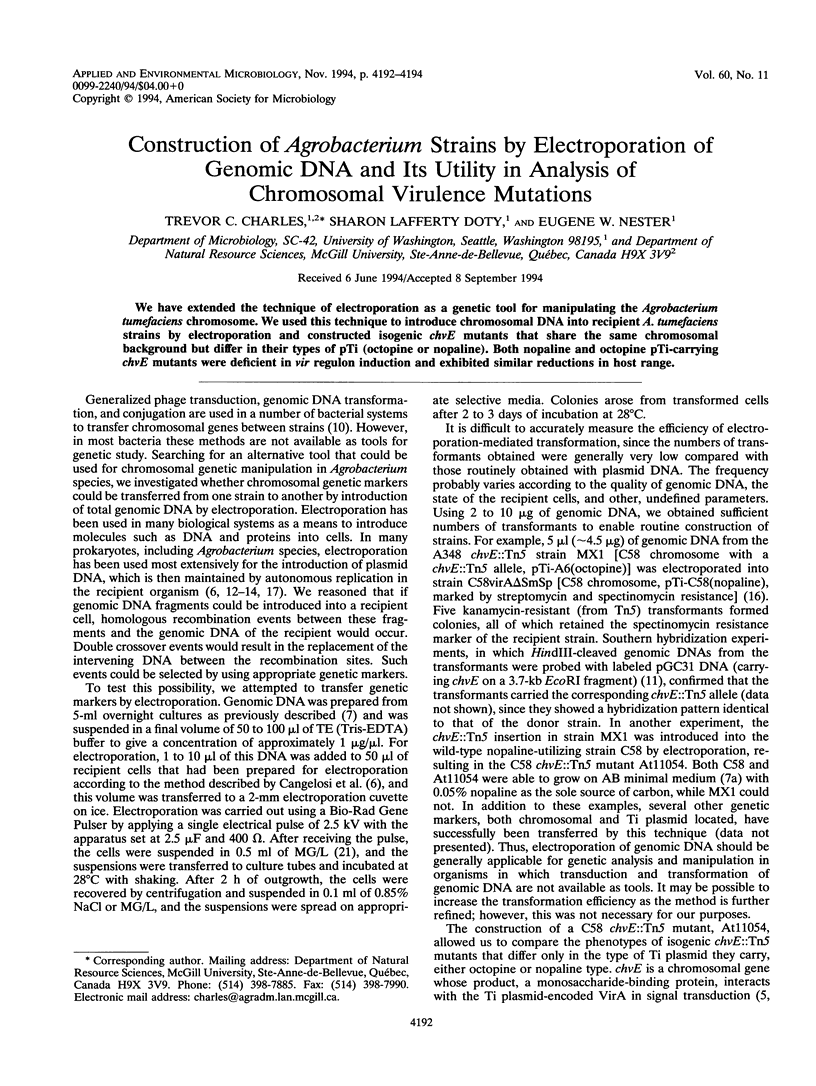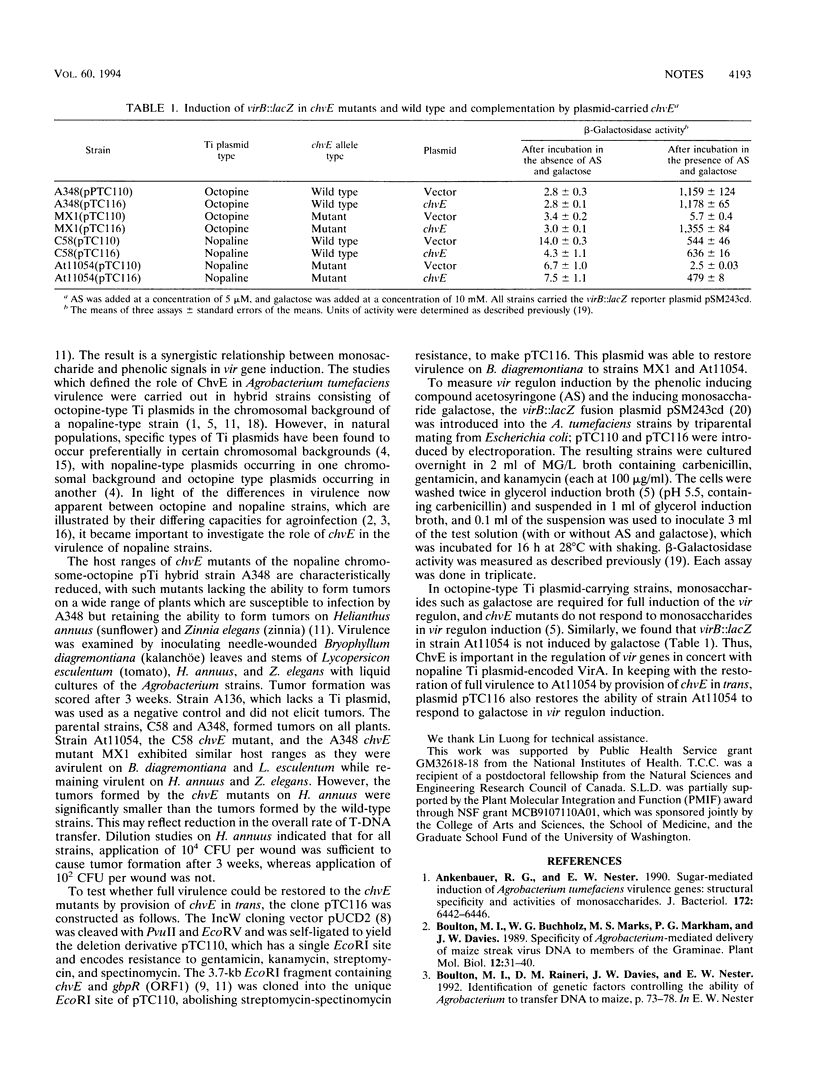Abstract
We have extended the technique of electroporation as a genetic tool for manipulating the Agrobacterium tumefaciens chromosome. We used this technique to introduce chromosomal DNA into recipient A. tumefaciens strains by electroporation and constructed isogenic chvE mutants that share the same chromosomal background but differ in their types of pTi (octopine or nopaline). Both nopaline and octopine pTi-carrying chvE mutants were deficient in vir regulon induction and exhibited similar reductions in host range.
Full text
PDF


Selected References
These references are in PubMed. This may not be the complete list of references from this article.
- Ankenbauer R. G., Nester E. W. Sugar-mediated induction of Agrobacterium tumefaciens virulence genes: structural specificity and activities of monosaccharides. J Bacteriol. 1990 Nov;172(11):6442–6446. doi: 10.1128/jb.172.11.6442-6446.1990. [DOI] [PMC free article] [PubMed] [Google Scholar]
- Bouzar H., Ouadah D., Krimi Z., Jones J. B., Trovato M., Petit A., Dessaux Y. Correlative Association between Resident Plasmids and the Host Chromosome in a Diverse Agrobacterium Soil Population. Appl Environ Microbiol. 1993 May;59(5):1310–1317. doi: 10.1128/aem.59.5.1310-1317.1993. [DOI] [PMC free article] [PubMed] [Google Scholar]
- Cangelosi G. A., Ankenbauer R. G., Nester E. W. Sugars induce the Agrobacterium virulence genes through a periplasmic binding protein and a transmembrane signal protein. Proc Natl Acad Sci U S A. 1990 Sep;87(17):6708–6712. doi: 10.1073/pnas.87.17.6708. [DOI] [PMC free article] [PubMed] [Google Scholar]
- Cangelosi G. A., Best E. A., Martinetti G., Nester E. W. Genetic analysis of Agrobacterium. Methods Enzymol. 1991;204:384–397. doi: 10.1016/0076-6879(91)04020-o. [DOI] [PubMed] [Google Scholar]
- Charles T. C., Nester E. W. A chromosomally encoded two-component sensory transduction system is required for virulence of Agrobacterium tumefaciens. J Bacteriol. 1993 Oct;175(20):6614–6625. doi: 10.1128/jb.175.20.6614-6625.1993. [DOI] [PMC free article] [PubMed] [Google Scholar]
- Chilton M. D., Currier T. C., Farrand S. K., Bendich A. J., Gordon M. P., Nester E. W. Agrobacterium tumefaciens DNA and PS8 bacteriophage DNA not detected in crown gall tumors. Proc Natl Acad Sci U S A. 1974 Sep;71(9):3672–3676. doi: 10.1073/pnas.71.9.3672. [DOI] [PMC free article] [PubMed] [Google Scholar]
- Close T. J., Zaitlin D., Kado C. I. Design and development of amplifiable broad-host-range cloning vectors: analysis of the vir region of Agrobacterium tumefaciens plasmid pTiC58. Plasmid. 1984 Sep;12(2):111–118. doi: 10.1016/0147-619x(84)90057-x. [DOI] [PubMed] [Google Scholar]
- Doty S. L., Chang M., Nester E. W. The chromosomal virulence gene, chvE, of Agrobacterium tumefaciens is regulated by a LysR family member. J Bacteriol. 1993 Dec;175(24):7880–7886. doi: 10.1128/jb.175.24.7880-7886.1993. [DOI] [PMC free article] [PubMed] [Google Scholar]
- Holloway B. W. Genetics for all bacteria. Annu Rev Microbiol. 1993;47:659–684. doi: 10.1146/annurev.mi.47.100193.003303. [DOI] [PubMed] [Google Scholar]
- Huang M. L., Cangelosi G. A., Halperin W., Nester E. W. A chromosomal Agrobacterium tumefaciens gene required for effective plant signal transduction. J Bacteriol. 1990 Apr;172(4):1814–1822. doi: 10.1128/jb.172.4.1814-1822.1990. [DOI] [PMC free article] [PubMed] [Google Scholar]
- Kilbane J. J., 2nd, Bielaga B. A. Instantaneous gene transfer from donor to recipient microorganisms via electroporation. Biotechniques. 1991 Mar;10(3):354–365. [PubMed] [Google Scholar]
- Mersereau M., Pazour G. J., Das A. Efficient transformation of Agrobacterium tumefaciens by electroporation. Gene. 1990 May 31;90(1):149–151. doi: 10.1016/0378-1119(90)90452-w. [DOI] [PubMed] [Google Scholar]
- Mozo T., Hooykaas P. J. Electroporation of megaplasmids into Agrobacterium. Plant Mol Biol. 1991 May;16(5):917–918. doi: 10.1007/BF00015085. [DOI] [PubMed] [Google Scholar]
- Raineri D. M., Boulton M. I., Davies J. W., Nester E. W. VirA, the plant-signal receptor, is responsible for the Ti plasmid-specific transfer of DNA to maize by Agrobacterium. Proc Natl Acad Sci U S A. 1993 Apr 15;90(8):3549–3553. doi: 10.1073/pnas.90.8.3549. [DOI] [PMC free article] [PubMed] [Google Scholar]
- Shen W. J., Forde B. G. Efficient transformation of Agrobacterium spp. by high voltage electroporation. Nucleic Acids Res. 1989 Oct 25;17(20):8385–8385. doi: 10.1093/nar/17.20.8385. [DOI] [PMC free article] [PubMed] [Google Scholar]
- Shimoda N., Toyoda-Yamamoto A., Nagamine J., Usami S., Katayama M., Sakagami Y., Machida Y. Control of expression of Agrobacterium vir genes by synergistic actions of phenolic signal molecules and monosaccharides. Proc Natl Acad Sci U S A. 1990 Sep;87(17):6684–6688. doi: 10.1073/pnas.87.17.6684. [DOI] [PMC free article] [PubMed] [Google Scholar]
- Stachel S. E., An G., Flores C., Nester E. W. A Tn3 lacZ transposon for the random generation of beta-galactosidase gene fusions: application to the analysis of gene expression in Agrobacterium. EMBO J. 1985 Apr;4(4):891–898. doi: 10.1002/j.1460-2075.1985.tb03715.x. [DOI] [PMC free article] [PubMed] [Google Scholar]
- Stachel S. E., Zambryski P. C. virA and virG control the plant-induced activation of the T-DNA transfer process of A. tumefaciens. Cell. 1986 Aug 1;46(3):325–333. doi: 10.1016/0092-8674(86)90653-7. [DOI] [PubMed] [Google Scholar]
- Young C., Nester E. W. Association of the virD2 protein with the 5' end of T strands in Agrobacterium tumefaciens. J Bacteriol. 1988 Aug;170(8):3367–3374. doi: 10.1128/jb.170.8.3367-3374.1988. [DOI] [PMC free article] [PubMed] [Google Scholar]


